PUBH6007 Report: Strategies for Obesity in Indigenous Australia
VerifiedAdded on 2022/09/07
|8
|1464
|26
Report
AI Summary
This report addresses the critical issue of obesity within the Indigenous Australian population. It outlines the program's goals, which aim to raise awareness and promote healthier lifestyles, particularly among children. The objectives include identifying the causes of obesity, collecting data, and assessing potential risks. Strategies encompass promoting healthy diets (emphasizing nutrient-rich foods and physical activity), and also focuses on childcare programs, reducing low birth weight babies, and controlling smoking. The report also details the risks, including premature death, diabetes, renal disease, and chronic diseases. It further specifies the resources required, including financial, physical, and human resources, for implementing the program. References to relevant studies are included, providing a basis for the proposed interventions and their evaluation.
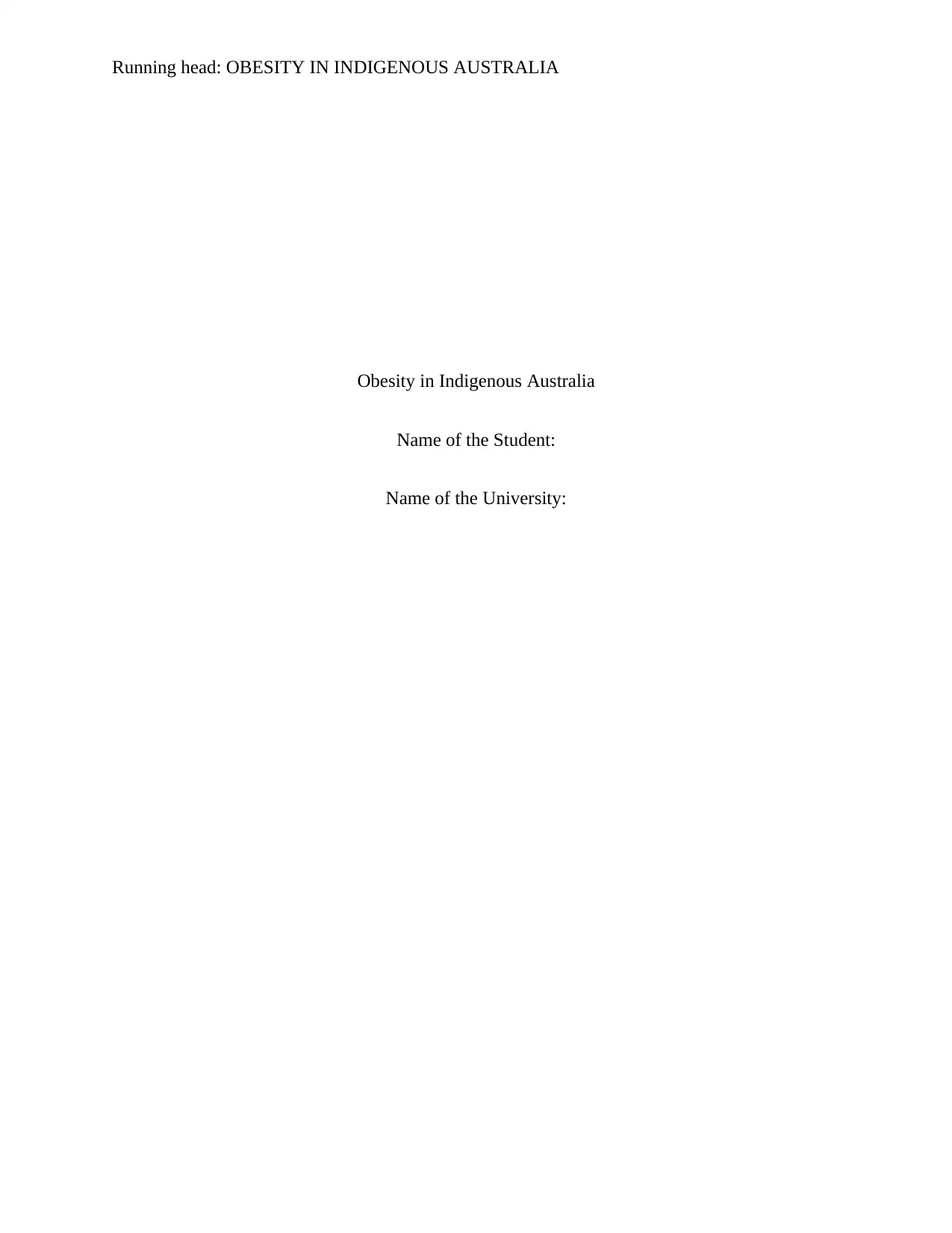
Running head: OBESITY IN INDIGENOUS AUSTRALIA
Obesity in Indigenous Australia
Name of the Student:
Name of the University:
Obesity in Indigenous Australia
Name of the Student:
Name of the University:
Paraphrase This Document
Need a fresh take? Get an instant paraphrase of this document with our AI Paraphraser

1OBESITY IN INDIGENOUS AUSTRALIA
Part 3: Summary
Goals of the program
It is identified that obesity is becoming a major concern for the Australian indigenous
people these days due to improper diet and very unhealthy regular life styles. The key issues with
the obesity are mainly facing by the aboriginal children who are coming across great social and
economical disadvantages. It is also found that obesity is the highest contributor to the health
gaps between the non aboriginal and aboriginal Australians. This gap is possibly increasing
among the aboriginal children and adults due to their remote living location and high rate of
population.
The program logic plan is developed to develop both long term and short term healthy
living plan for the indigenous people of Australia. It is determined that if the program planned is
properly followed and maintained by the living people then they would be able to get a better as
well as healthier lifestyle than current. The goals of the program is to increase awareness among
the indigenous people and make them realize what actual issues they are going to face if still
they do not follow a good and healthier life styles. In this program plan detail obesity prevention
strategies are also evaluated followed by possible risks and challenges. Not only this but also,
developing proper obesity prevention strategies are also part of the program planning.
Objectives
The objectives for the program plan are as follows:
To identify the reasons behind excessive obesity
To collect useful data from different sources to develop strategies
Part 3: Summary
Goals of the program
It is identified that obesity is becoming a major concern for the Australian indigenous
people these days due to improper diet and very unhealthy regular life styles. The key issues with
the obesity are mainly facing by the aboriginal children who are coming across great social and
economical disadvantages. It is also found that obesity is the highest contributor to the health
gaps between the non aboriginal and aboriginal Australians. This gap is possibly increasing
among the aboriginal children and adults due to their remote living location and high rate of
population.
The program logic plan is developed to develop both long term and short term healthy
living plan for the indigenous people of Australia. It is determined that if the program planned is
properly followed and maintained by the living people then they would be able to get a better as
well as healthier lifestyle than current. The goals of the program is to increase awareness among
the indigenous people and make them realize what actual issues they are going to face if still
they do not follow a good and healthier life styles. In this program plan detail obesity prevention
strategies are also evaluated followed by possible risks and challenges. Not only this but also,
developing proper obesity prevention strategies are also part of the program planning.
Objectives
The objectives for the program plan are as follows:
To identify the reasons behind excessive obesity
To collect useful data from different sources to develop strategies
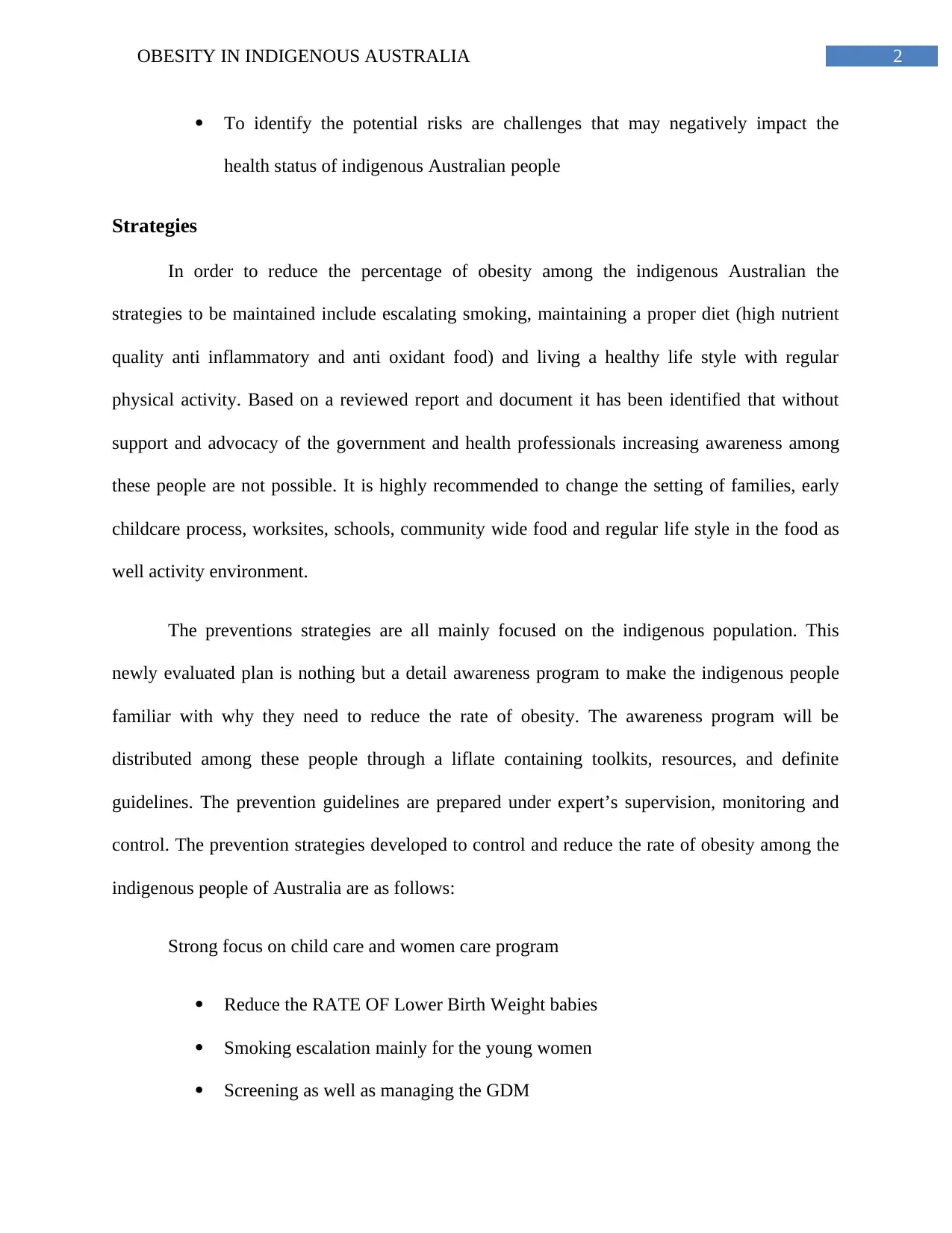
2OBESITY IN INDIGENOUS AUSTRALIA
To identify the potential risks are challenges that may negatively impact the
health status of indigenous Australian people
Strategies
In order to reduce the percentage of obesity among the indigenous Australian the
strategies to be maintained include escalating smoking, maintaining a proper diet (high nutrient
quality anti inflammatory and anti oxidant food) and living a healthy life style with regular
physical activity. Based on a reviewed report and document it has been identified that without
support and advocacy of the government and health professionals increasing awareness among
these people are not possible. It is highly recommended to change the setting of families, early
childcare process, worksites, schools, community wide food and regular life style in the food as
well activity environment.
The preventions strategies are all mainly focused on the indigenous population. This
newly evaluated plan is nothing but a detail awareness program to make the indigenous people
familiar with why they need to reduce the rate of obesity. The awareness program will be
distributed among these people through a liflate containing toolkits, resources, and definite
guidelines. The prevention guidelines are prepared under expert’s supervision, monitoring and
control. The prevention strategies developed to control and reduce the rate of obesity among the
indigenous people of Australia are as follows:
Strong focus on child care and women care program
Reduce the RATE OF Lower Birth Weight babies
Smoking escalation mainly for the young women
Screening as well as managing the GDM
To identify the potential risks are challenges that may negatively impact the
health status of indigenous Australian people
Strategies
In order to reduce the percentage of obesity among the indigenous Australian the
strategies to be maintained include escalating smoking, maintaining a proper diet (high nutrient
quality anti inflammatory and anti oxidant food) and living a healthy life style with regular
physical activity. Based on a reviewed report and document it has been identified that without
support and advocacy of the government and health professionals increasing awareness among
these people are not possible. It is highly recommended to change the setting of families, early
childcare process, worksites, schools, community wide food and regular life style in the food as
well activity environment.
The preventions strategies are all mainly focused on the indigenous population. This
newly evaluated plan is nothing but a detail awareness program to make the indigenous people
familiar with why they need to reduce the rate of obesity. The awareness program will be
distributed among these people through a liflate containing toolkits, resources, and definite
guidelines. The prevention guidelines are prepared under expert’s supervision, monitoring and
control. The prevention strategies developed to control and reduce the rate of obesity among the
indigenous people of Australia are as follows:
Strong focus on child care and women care program
Reduce the RATE OF Lower Birth Weight babies
Smoking escalation mainly for the young women
Screening as well as managing the GDM
⊘ This is a preview!⊘
Do you want full access?
Subscribe today to unlock all pages.

Trusted by 1+ million students worldwide
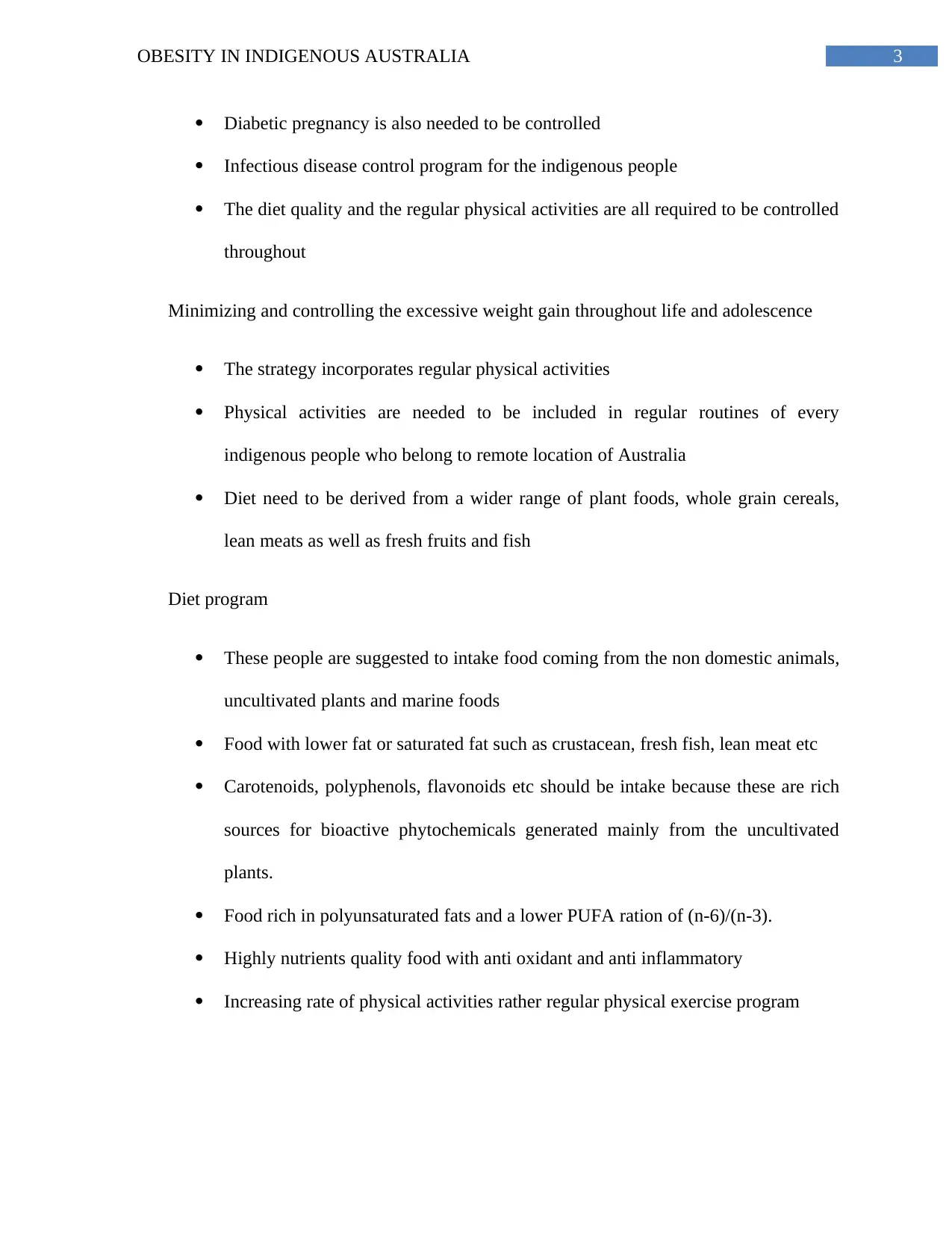
3OBESITY IN INDIGENOUS AUSTRALIA
Diabetic pregnancy is also needed to be controlled
Infectious disease control program for the indigenous people
The diet quality and the regular physical activities are all required to be controlled
throughout
Minimizing and controlling the excessive weight gain throughout life and adolescence
The strategy incorporates regular physical activities
Physical activities are needed to be included in regular routines of every
indigenous people who belong to remote location of Australia
Diet need to be derived from a wider range of plant foods, whole grain cereals,
lean meats as well as fresh fruits and fish
Diet program
These people are suggested to intake food coming from the non domestic animals,
uncultivated plants and marine foods
Food with lower fat or saturated fat such as crustacean, fresh fish, lean meat etc
Carotenoids, polyphenols, flavonoids etc should be intake because these are rich
sources for bioactive phytochemicals generated mainly from the uncultivated
plants.
Food rich in polyunsaturated fats and a lower PUFA ration of (n-6)/(n-3).
Highly nutrients quality food with anti oxidant and anti inflammatory
Increasing rate of physical activities rather regular physical exercise program
Diabetic pregnancy is also needed to be controlled
Infectious disease control program for the indigenous people
The diet quality and the regular physical activities are all required to be controlled
throughout
Minimizing and controlling the excessive weight gain throughout life and adolescence
The strategy incorporates regular physical activities
Physical activities are needed to be included in regular routines of every
indigenous people who belong to remote location of Australia
Diet need to be derived from a wider range of plant foods, whole grain cereals,
lean meats as well as fresh fruits and fish
Diet program
These people are suggested to intake food coming from the non domestic animals,
uncultivated plants and marine foods
Food with lower fat or saturated fat such as crustacean, fresh fish, lean meat etc
Carotenoids, polyphenols, flavonoids etc should be intake because these are rich
sources for bioactive phytochemicals generated mainly from the uncultivated
plants.
Food rich in polyunsaturated fats and a lower PUFA ration of (n-6)/(n-3).
Highly nutrients quality food with anti oxidant and anti inflammatory
Increasing rate of physical activities rather regular physical exercise program
Paraphrase This Document
Need a fresh take? Get an instant paraphrase of this document with our AI Paraphraser
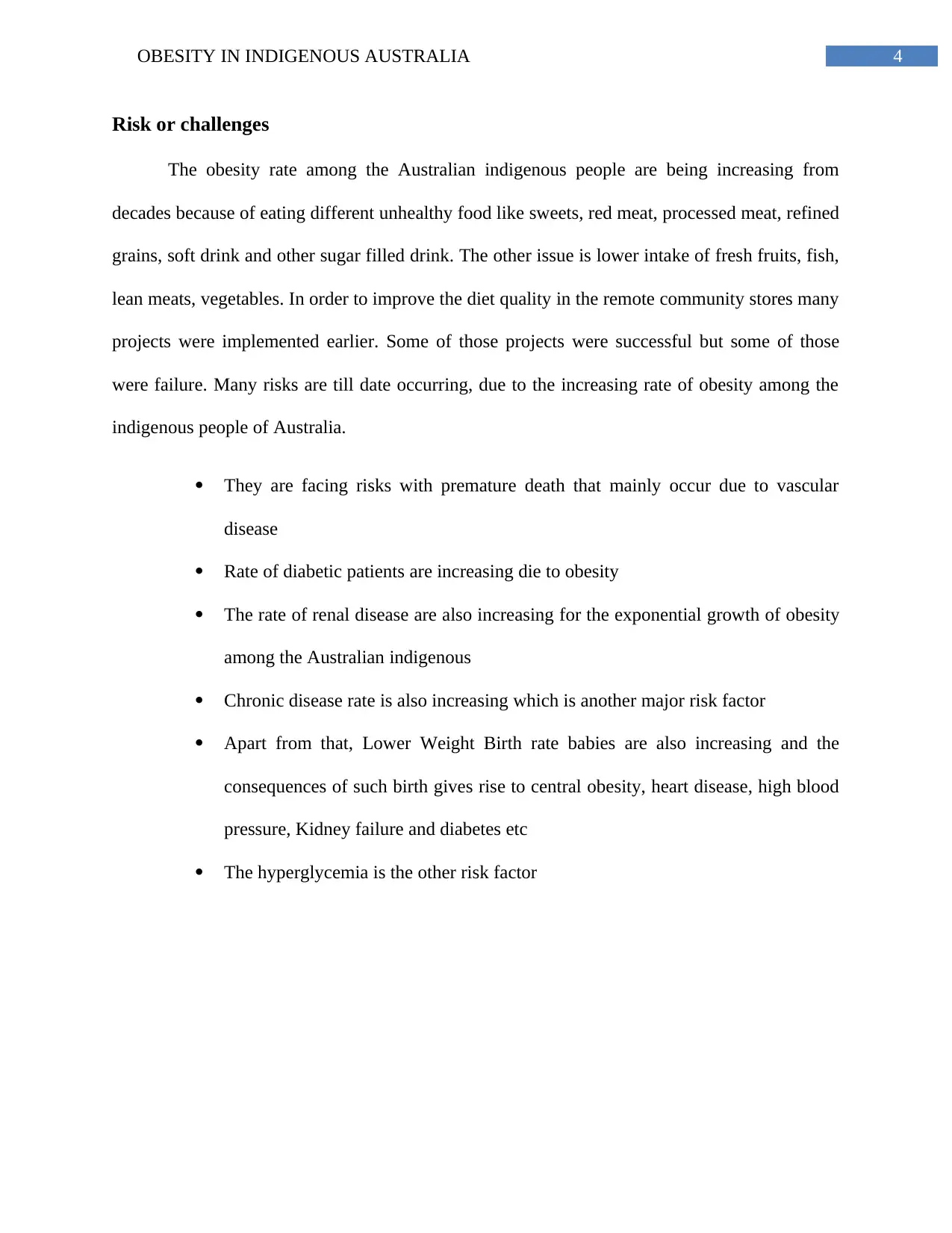
4OBESITY IN INDIGENOUS AUSTRALIA
Risk or challenges
The obesity rate among the Australian indigenous people are being increasing from
decades because of eating different unhealthy food like sweets, red meat, processed meat, refined
grains, soft drink and other sugar filled drink. The other issue is lower intake of fresh fruits, fish,
lean meats, vegetables. In order to improve the diet quality in the remote community stores many
projects were implemented earlier. Some of those projects were successful but some of those
were failure. Many risks are till date occurring, due to the increasing rate of obesity among the
indigenous people of Australia.
They are facing risks with premature death that mainly occur due to vascular
disease
Rate of diabetic patients are increasing die to obesity
The rate of renal disease are also increasing for the exponential growth of obesity
among the Australian indigenous
Chronic disease rate is also increasing which is another major risk factor
Apart from that, Lower Weight Birth rate babies are also increasing and the
consequences of such birth gives rise to central obesity, heart disease, high blood
pressure, Kidney failure and diabetes etc
The hyperglycemia is the other risk factor
Risk or challenges
The obesity rate among the Australian indigenous people are being increasing from
decades because of eating different unhealthy food like sweets, red meat, processed meat, refined
grains, soft drink and other sugar filled drink. The other issue is lower intake of fresh fruits, fish,
lean meats, vegetables. In order to improve the diet quality in the remote community stores many
projects were implemented earlier. Some of those projects were successful but some of those
were failure. Many risks are till date occurring, due to the increasing rate of obesity among the
indigenous people of Australia.
They are facing risks with premature death that mainly occur due to vascular
disease
Rate of diabetic patients are increasing die to obesity
The rate of renal disease are also increasing for the exponential growth of obesity
among the Australian indigenous
Chronic disease rate is also increasing which is another major risk factor
Apart from that, Lower Weight Birth rate babies are also increasing and the
consequences of such birth gives rise to central obesity, heart disease, high blood
pressure, Kidney failure and diabetes etc
The hyperglycemia is the other risk factor
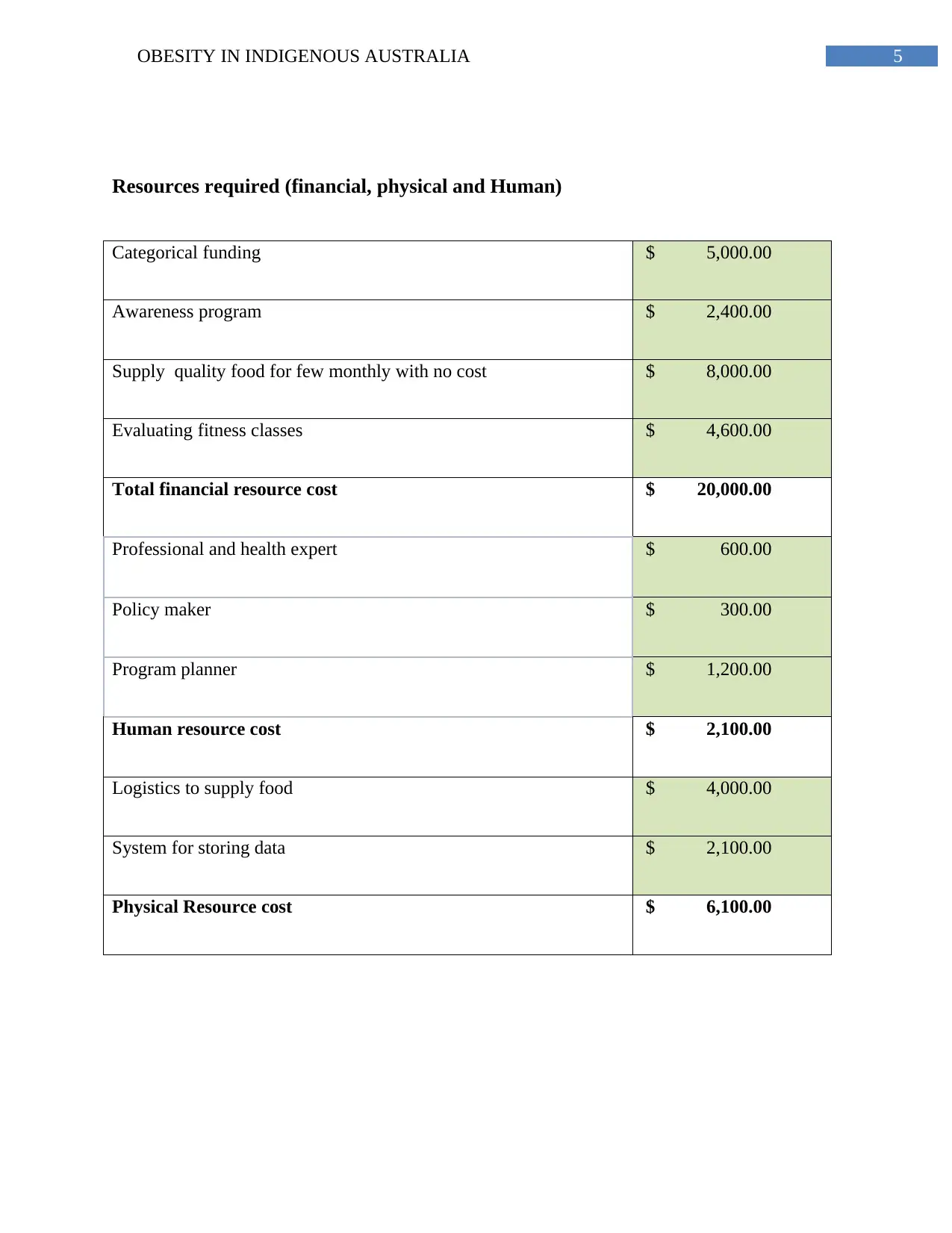
5OBESITY IN INDIGENOUS AUSTRALIA
Resources required (financial, physical and Human)
Categorical funding $ 5,000.00
Awareness program $ 2,400.00
Supply quality food for few monthly with no cost $ 8,000.00
Evaluating fitness classes $ 4,600.00
Total financial resource cost $ 20,000.00
Professional and health expert $ 600.00
Policy maker $ 300.00
Program planner $ 1,200.00
Human resource cost $ 2,100.00
Logistics to supply food $ 4,000.00
System for storing data $ 2,100.00
Physical Resource cost $ 6,100.00
Resources required (financial, physical and Human)
Categorical funding $ 5,000.00
Awareness program $ 2,400.00
Supply quality food for few monthly with no cost $ 8,000.00
Evaluating fitness classes $ 4,600.00
Total financial resource cost $ 20,000.00
Professional and health expert $ 600.00
Policy maker $ 300.00
Program planner $ 1,200.00
Human resource cost $ 2,100.00
Logistics to supply food $ 4,000.00
System for storing data $ 2,100.00
Physical Resource cost $ 6,100.00
⊘ This is a preview!⊘
Do you want full access?
Subscribe today to unlock all pages.

Trusted by 1+ million students worldwide
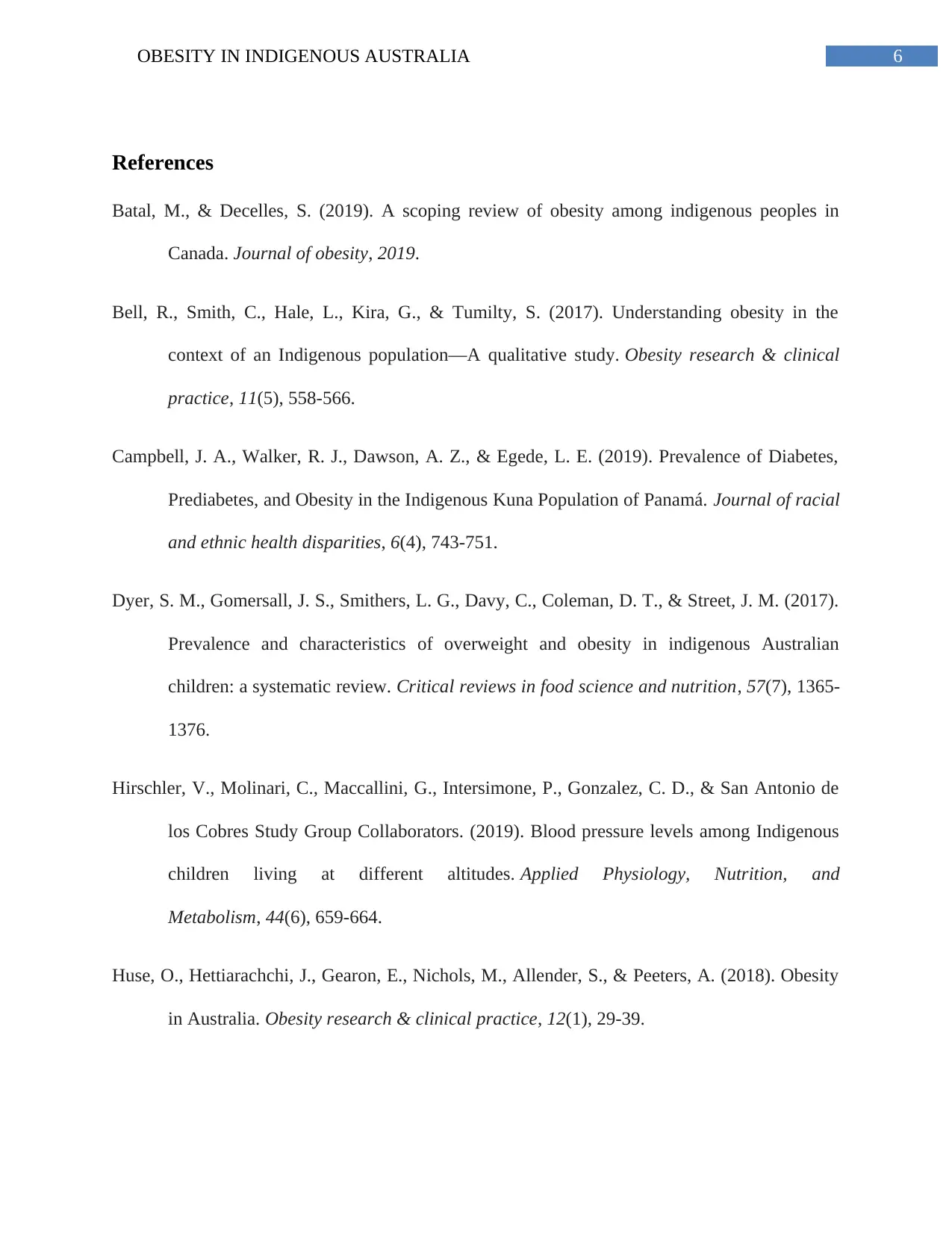
6OBESITY IN INDIGENOUS AUSTRALIA
References
Batal, M., & Decelles, S. (2019). A scoping review of obesity among indigenous peoples in
Canada. Journal of obesity, 2019.
Bell, R., Smith, C., Hale, L., Kira, G., & Tumilty, S. (2017). Understanding obesity in the
context of an Indigenous population—A qualitative study. Obesity research & clinical
practice, 11(5), 558-566.
Campbell, J. A., Walker, R. J., Dawson, A. Z., & Egede, L. E. (2019). Prevalence of Diabetes,
Prediabetes, and Obesity in the Indigenous Kuna Population of Panamá. Journal of racial
and ethnic health disparities, 6(4), 743-751.
Dyer, S. M., Gomersall, J. S., Smithers, L. G., Davy, C., Coleman, D. T., & Street, J. M. (2017).
Prevalence and characteristics of overweight and obesity in indigenous Australian
children: a systematic review. Critical reviews in food science and nutrition, 57(7), 1365-
1376.
Hirschler, V., Molinari, C., Maccallini, G., Intersimone, P., Gonzalez, C. D., & San Antonio de
los Cobres Study Group Collaborators. (2019). Blood pressure levels among Indigenous
children living at different altitudes. Applied Physiology, Nutrition, and
Metabolism, 44(6), 659-664.
Huse, O., Hettiarachchi, J., Gearon, E., Nichols, M., Allender, S., & Peeters, A. (2018). Obesity
in Australia. Obesity research & clinical practice, 12(1), 29-39.
References
Batal, M., & Decelles, S. (2019). A scoping review of obesity among indigenous peoples in
Canada. Journal of obesity, 2019.
Bell, R., Smith, C., Hale, L., Kira, G., & Tumilty, S. (2017). Understanding obesity in the
context of an Indigenous population—A qualitative study. Obesity research & clinical
practice, 11(5), 558-566.
Campbell, J. A., Walker, R. J., Dawson, A. Z., & Egede, L. E. (2019). Prevalence of Diabetes,
Prediabetes, and Obesity in the Indigenous Kuna Population of Panamá. Journal of racial
and ethnic health disparities, 6(4), 743-751.
Dyer, S. M., Gomersall, J. S., Smithers, L. G., Davy, C., Coleman, D. T., & Street, J. M. (2017).
Prevalence and characteristics of overweight and obesity in indigenous Australian
children: a systematic review. Critical reviews in food science and nutrition, 57(7), 1365-
1376.
Hirschler, V., Molinari, C., Maccallini, G., Intersimone, P., Gonzalez, C. D., & San Antonio de
los Cobres Study Group Collaborators. (2019). Blood pressure levels among Indigenous
children living at different altitudes. Applied Physiology, Nutrition, and
Metabolism, 44(6), 659-664.
Huse, O., Hettiarachchi, J., Gearon, E., Nichols, M., Allender, S., & Peeters, A. (2018). Obesity
in Australia. Obesity research & clinical practice, 12(1), 29-39.
Paraphrase This Document
Need a fresh take? Get an instant paraphrase of this document with our AI Paraphraser
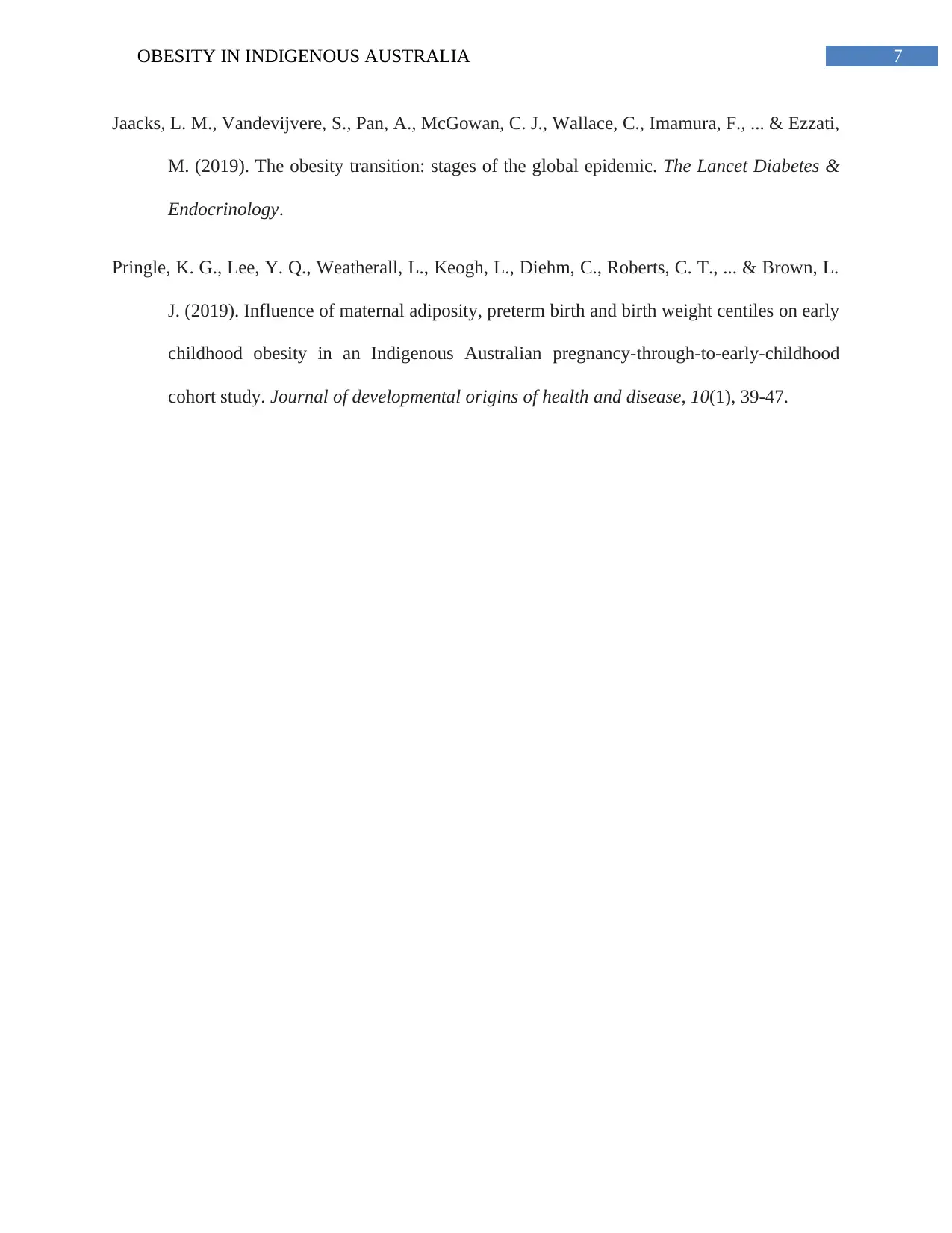
7OBESITY IN INDIGENOUS AUSTRALIA
Jaacks, L. M., Vandevijvere, S., Pan, A., McGowan, C. J., Wallace, C., Imamura, F., ... & Ezzati,
M. (2019). The obesity transition: stages of the global epidemic. The Lancet Diabetes &
Endocrinology.
Pringle, K. G., Lee, Y. Q., Weatherall, L., Keogh, L., Diehm, C., Roberts, C. T., ... & Brown, L.
J. (2019). Influence of maternal adiposity, preterm birth and birth weight centiles on early
childhood obesity in an Indigenous Australian pregnancy-through-to-early-childhood
cohort study. Journal of developmental origins of health and disease, 10(1), 39-47.
Jaacks, L. M., Vandevijvere, S., Pan, A., McGowan, C. J., Wallace, C., Imamura, F., ... & Ezzati,
M. (2019). The obesity transition: stages of the global epidemic. The Lancet Diabetes &
Endocrinology.
Pringle, K. G., Lee, Y. Q., Weatherall, L., Keogh, L., Diehm, C., Roberts, C. T., ... & Brown, L.
J. (2019). Influence of maternal adiposity, preterm birth and birth weight centiles on early
childhood obesity in an Indigenous Australian pregnancy-through-to-early-childhood
cohort study. Journal of developmental origins of health and disease, 10(1), 39-47.
1 out of 8
Related Documents
Your All-in-One AI-Powered Toolkit for Academic Success.
+13062052269
info@desklib.com
Available 24*7 on WhatsApp / Email
![[object Object]](/_next/static/media/star-bottom.7253800d.svg)
Unlock your academic potential
Copyright © 2020–2025 A2Z Services. All Rights Reserved. Developed and managed by ZUCOL.





